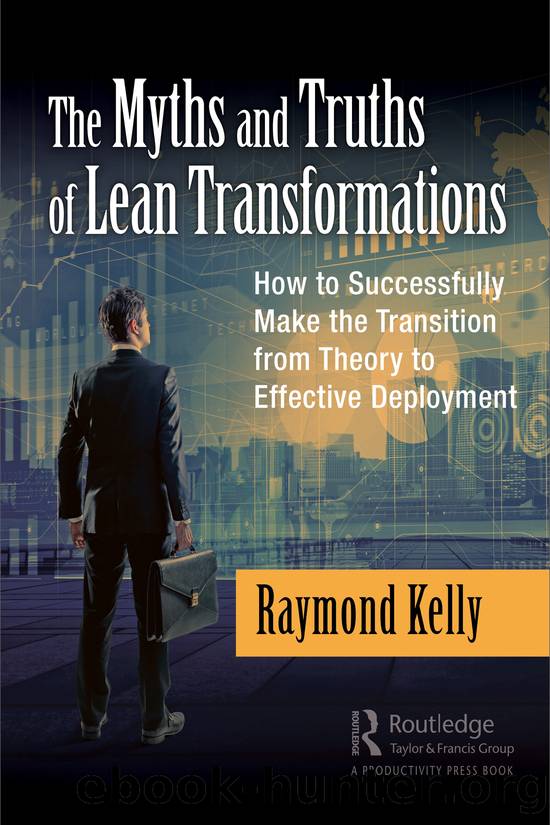The Myths and Truths of Lean Transformations by Raymond Kelly

Author:Raymond Kelly
Language: eng
Format: epub
ISBN: 9781351584975
Publisher: Taylor & Francis (CAM)
Figure 3.2 Little’s Law.
– the less inventory, the smoother and faster the flow;
■ Motion: Eliminate unnecessary movements and ensure the principles of motion are adhered to.
■ Wait: Eliminate waiting through:
– workload balancing of operators and equipment;
– Standard Work – minimize variations that lead to delays;
– visual controls – proactively highlight delays.
■ Overproduction: Do not overproduce. Refer to Little’s Law: inventory decreases your throughput velocity:
– utilize Standard Work-in-Process (SWIP) to control amount of inventory allowed on the production line/cell and the amount of inventory allowed within the production area/workspace.
■ Over-processing: Simple over-processing steps can disrupt flow; e.g. too many approvals/signatures, too many hand-offs, excessive inspections, any just-in-case activities, etc.:
– if it’s not adding value to the customer, then eliminate it.
■ Defects: As previously discussed, long processing times contribute to the creation of defects and to deferred detection of real-time quality issues;
■ Muri: Don’t overburden your people, equipment, or manufacturing cells:
– overburdening disrupts flow: overburdening of associates may lead or contribute to increased fatigue or absenteeism; overburdening of equipment may lead to increased minor stoppages or increased downtime; overburdening of equipment can lead to a reduction of equipment performance.
■ Mura: Unevenness is the enemy of flow:
– eliminate unevenness by balancing the manufacturing cells;
– remove production unevenness with the aid of SWIP;
– decouple operations with large differences in process lead times and/or cycle times using supermarkets;
■ utilize manufacturing run strategies and load-leveling methodologies (e.g. heijunka boards, kanbans, etc.) to smooth production.
The objective of flow production is to create continuous (non-stop) flow. Continuous flow is producing and moving one item at a time (or a small consistent batch of items) through a series of processing steps as continuously as possible, with each step making only what is requested by the next step.
Continuous flow can be realized in numerous ways:
■ one-piece or single-piece flow (remember a small lot or batch of items can be considered “one-piece”);
■ moving assembly lines (automatically paced lines, motorized conveyors, etc.);
■ push-assembly lines (slide-lines); e.g. make one, move one.
Figure 3.3 shows an example of a continuous-flow assembly line (note: no inventory between units being assembled).
Download
This site does not store any files on its server. We only index and link to content provided by other sites. Please contact the content providers to delete copyright contents if any and email us, we'll remove relevant links or contents immediately.
Storytelling for dummies by Andrea Fontana(1494)
Effortless by Greg McKeown(1434)
The Practice by Seth Godin(1405)
Mastering Blockchain by Lorne Lantz(1392)
Blockchain Quick Reference by Paul Valencourt & Samanyu Chopra & Brenn Hill(1149)
Mastering Blockchain by Lorne Lantz & Daniel Cawrey(909)
The wind in the willows by Kenneth Grahame(851)
How to Lead by David M. Rubenstein(825)
The Ape in the Corner Office by Richard Conniff(792)
Social Media Engagement For Dummies by Aliza Sherman(711)
Handbook of Big Data Analytics by Unknown(711)
Taking Care of Yourself (HBR Working Parents Series) by Harvard Business Review(698)
Getting Started with Data: The first book you should read to successfully get along with data. by Menegatti Gabriel & Team Simbiose Ventures(694)
FunRetrospectives: activities and ideas for making agile retrospectives more engaging by Paulo Caroli & Tainã Caetano Coimbra(691)
Business Storytelling For Dummies by Unknown(670)
Evernote for Self Publishing: How to Write Your Book in Evernote from Start to Finish by Jose John(667)
Help! My Facebook Ads Suck-- by M. D. Cooper & Jill Cooper(653)
A Leader Listens by Ajay Banga(639)
Genius by Choice: Your unconventional A–Z handbook to enhance your learning process by Remondino Giulia S(638)
